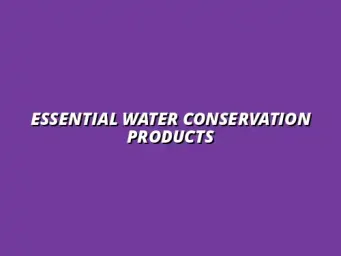Understanding Smart Irrigation Systems and Their Importance
Smart irrigation systems are innovative solutions designed to optimize water usage for gardens, lawns, and agricultural fields. They utilize advanced technologies to ensure that plants receive the right amount of water at the right time. This not only helps in conserving water but also enhances plant health and reduces the overall maintenance required.
These systems are becoming increasingly popular as awareness of water conservation grows. With climate change affecting weather patterns and increasing water scarcity, it has become essential to adopt efficient irrigation practices. By understanding smart irrigation systems, we can significantly reduce our water footprint while promoting sustainable practices. Learn more about simple water-saving tips for your home to complement your smart irrigation system.
Defining Smart Irrigation Systems
At its core, a smart irrigation system is an automated way to manage water delivery to plants. It leverages technology such as sensors, controllers, and software to monitor and regulate water consumption. This means that water is applied based on real-time data rather than a predetermined schedule.
In simple terms, smart irrigation adapts to environmental conditions, ensuring that plants are neither overwatered nor underwatered. This adaptability is what sets smart systems apart from traditional irrigation methods, making them a key player in efficient water management.
Overview of Technology Utilized in Smart Irrigation
Smart irrigation systems employ various technologies to manage water usage effectively. Key technologies include:
- Soil moisture sensors: These detect the moisture level in the soil and determine when irrigation is needed.
- Weather stations: These provide data on local weather conditions, helping to adjust watering schedules accordingly.
- Mobile apps and cloud software: These allow users to monitor and control their irrigation systems remotely.
By utilizing these technologies, smart irrigation systems can optimize water delivery and enhance overall system performance. Understanding the benefits of water-efficient irrigation can further highlight the value of these systems.
Types of Smart Irrigation Systems Available
There are several types of smart irrigation systems tailored to meet different needs. Some popular options include:
- Drip irrigation: Delivers water directly to the roots of plants, minimizing evaporation.
- Sprinkler systems: Can be automated to adjust based on weather conditions and plant needs.
- Hybrid systems: Combine various methods to offer flexible watering solutions.
Each system has its advantages, and the choice ultimately depends on factors like the type of plants, soil conditions, and the overall landscape design.
The Role of Smart Irrigation in Water Conservation
Smart irrigation plays a crucial role in reducing water waste. By applying water only when necessary, these systems help ensure that every drop counts. This is especially important in regions facing water scarcity or drought conditions.
Moreover, efficient water management through smart irrigation not only benefits the environment but also allows users to lower their water bills. It's a win-win solution for everyone involved! Consider exploring rainwater harvesting for water conservation to further enhance your water-saving efforts.
How Smart Irrigation Reduces Water Waste
One of the primary advantages of smart irrigation systems is their ability to minimize water wastage. They do this by:
- Using real-time data to adjust watering schedules based on weather patterns.
- Employing soil moisture sensors to determine the actual need for water.
- Implementing drip systems that deliver water directly to plant roots.
These features significantly cut down on unnecessary water usage and help in maintaining a healthy ecosystem.
Environmental Benefits of Efficient Water Management
Efficient water management goes beyond just saving water; it has profound effects on the environment. Some of these benefits include:
- Improved plant health: Plants receive adequate water, promoting growth.
- Reduced runoff: Less water means less runoff, which can help prevent soil erosion.
- Conservation of local water resources: Helps protect lakes, rivers, and groundwater.
By adopting smart irrigation systems, we contribute to a healthier environment and a more sustainable future. Simple changes in your plumbing can also make a difference; check out these water-saving plumbing tips.
Key Components of Smart Irrigation Systems
To maximize efficiency, smart irrigation systems consist of several critical components. Each plays a vital role in ensuring effective water management. Understanding these components helps users make informed decisions about their irrigation setups.
Among the key components, soil moisture sensors and weather-based controllers stand out.
Soil Moisture Sensors and Their Functionality
Soil moisture sensors measure the water content in the soil, providing valuable data for irrigation management. They ensure that water is applied based on the actual moisture levels rather than on a fixed schedule. This prevents overwatering and keeps plants healthy.
By using these sensors, homeowners and farmers can make informed decisions about when to irrigate, thus saving time and resources. They are crucial in modern smart irrigation systems!
Weather-based Controllers and Their Impact on Water Use
Weather-based controllers are essential for adapting irrigation schedules based on real-time weather data. These systems can adjust watering times and amounts based on rainfall, temperature, and humidity levels. This ensures efficient water usage and reduces waste.
Implementing such controllers can lead to significant savings in water consumption while maintaining plant health. They represent the future of irrigation management!
Factors Driving the Adoption of Smart Irrigation Systems
As awareness grows about the importance of water conservation, more individuals and organizations are adopting smart irrigation systems. Several factors drive this trend, making these systems increasingly appealing.
Key influences include economic incentives and regulatory support, which encourage users to invest in these innovative solutions.
Economic Incentives and Cost Savings for Users
Many users find that the initial investment in smart irrigation systems pays off in the long run. Proper kitchen plumbing maintenance can also contribute to overall water savings in your home.
- Lower water bills due to reduced consumption.
- Increased property values as a result of efficient landscaping.
- Potential tax breaks or rebates from local governments for adopting eco-friendly practices.
These financial benefits make smart irrigation systems an attractive option for homeowners and businesses alike.
Regulatory Support and Environmental Awareness
Government regulations and initiatives promoting water conservation have also influenced the adoption of smart irrigation. Many local authorities provide guidelines and programs that encourage residents to use efficient irrigation technologies. Additionally, as public awareness of environmental issues grows, more people are motivated to adopt sustainable practices.
This regulatory support, combined with increasing environmental consciousness, drives the shift towards smart irrigation systems that benefit both users and the planet.
Addressing Common Questions about Smart Irrigation Systems
What are the costs involved in installing Smart Irrigation?
When it comes to installing smart irrigation systems, many homeowners and farmers often wonder about the costs. The initial investment can vary widely depending on the type of system chosen and the size of the area being irrigated. However, considering the long-term savings from reduced water bills and enhanced efficiency is crucial!
On average, homeowners might spend anywhere from $1,500 to $5,000 on a smart irrigation system. This includes equipment like sensors, controllers, and installation. Yet, the benefits usually outweigh the costs, especially when you factor in potential savings and increased plant health over time. Regular maintenance, such as preventing scale buildup in your water heater, can also contribute to long-term cost savings.
- Initial setup costs can be high.
- Long-term savings include lower water bills.
- Enhanced plant health and growth can lead to better yields.
Initial Investment vs. Long-term Savings
While the upfront costs can seem daunting, it’s essential to look at the long-term savings smart irrigation systems provide. Reduced water usage can significantly decrease monthly bills, making the system pay for itself over time. Additionally, by optimizing watering schedules, plants thrive, reducing the need for replacements.
Investing in smart irrigation is like planting a seed; it may take time to see the benefits, but with proper care and attention, the rewards can be abundant! Many users report savings of up to 30% on water costs after switching to smart systems.
Government Grants and Subsidies for Smart Irrigation
Many governments offer grants and subsidies to encourage the adoption of smart irrigation systems. These financial incentives can help offset the initial investment, making it easier for homeowners and farmers to transition to smart technology. Programs often focus on water conservation, promoting sustainable practices that benefit everyone.
Potential sources of funding may include:
- State and federal grants specifically for water conservation.
- Local government programs aimed at incentivizing smart irrigation.
- Utility company rebates for reduced water usage.
How do Smart Irrigation Systems integrate with existing setups?
Many people worry about how smart irrigation systems will fit with their current irrigation setups. Fortunately, most smart systems are designed to be compatible with traditional irrigation methods. Understanding how to assess compatibility can ease this transition!
Before making changes, it’s essential to evaluate the existing irrigation setup. This can involve checking the type of equipment already in use, such as hoses, sprinklers, or drip systems. With the right tools, the upgrade to smart technology can often be seamless.
Assessing Compatibility with Traditional Irrigation Systems
To ensure a smooth integration, consider the following steps:
- Identify the components of your existing setup.
- Determine if any parts can be reused, such as pipes and emitters.
- Check for specific requirements of the smart system you want to install.
By assessing what you currently have, it becomes much easier to plan for an upgrade. This proactive approach helps to minimize costs and disruptions during the transition.
Upgrading to Smart Technology: A Step-by-Step Guide
Upgrading to smart technology doesn't have to be overwhelming! Here’s a simple guide to get started:
- Research and select a smart irrigation system that suits your needs.
- Gather information on your existing setup to identify compatibility.
- Purchase the necessary components and schedule installation.
- Test the system to ensure it’s working correctly.
Following these steps will help you successfully implement a smart irrigation system. Remember, taking the leap towards smarter water management is a significant step for both your plants and the environment! For further assistance with plumbing issues, consider contacting a plumber in Alcester, Birmingham.
Future Trends and Innovations in Smart Irrigation
Emerging Technologies Shaping the Future of Irrigation
The future of irrigation is bright with emerging technologies leading the way! Innovations in smart irrigation systems are not just about saving water, but also about creating more efficient and effective solutions for various settings. Stay tuned for what’s to come!
Technologies such as artificial intelligence and the Internet of Things (IoT) are playing vital roles in shaping these advancements. By utilizing real-time data, these technologies enable systems to adjust watering schedules based on current environmental conditions.
Artificial Intelligence and Machine Learning in Water Management
AI and machine learning are game-changers in smart irrigation. They can analyze data to make precise watering recommendations based on factors like soil moisture, weather forecasts, and plant needs. Here’s how they help:
- Predictive analytics for optimal watering times.
- Data-driven insights for better crop management.
- Adaptive learning to improve efficiency over time.
As these technologies continue to evolve, we can expect even more innovative solutions to emerge, making irrigation smarter and more sustainable.
Integration with IoT for Enhanced Efficiency
The integration of IoT with smart irrigation systems is an exciting trend! IoT devices can connect various components, providing real-time monitoring and management capabilities. This lets users access data from anywhere, making it easier to control their irrigation systems remotely.
Some benefits of IoT integration include:
- Real-time updates on soil conditions and weather.
- Remote access through mobile apps.
- Automated adjustments based on data analysis.
The combination of smart technology and IoT is paving the path toward a future where water conservation is more efficient than ever!
Community Involvement in Water Conservation Practices
Community involvement plays a crucial role in promoting water conservation practices. By engaging residents in efforts to adopt smart irrigation, we can all contribute to making a difference! Building awareness is key to success.
Effective community involvement can lead to widespread adoption of smart irrigation practices. Events, workshops, and educational sessions can foster greater understanding and encourage participation.
Building Awareness and Engagement Among Residents
To build awareness and engagement, consider these strategies:
- Host informational workshops on smart irrigation benefits.
- Create community groups focused on water conservation.
- Utilize social media campaigns to spread the word.
When residents become informed and motivated, they’re more likely to implement sustainable practices and support community initiatives!
Partnerships Between Local Governments and Technology Providers
Collaborations between local governments and technology providers can enhance water conservation efforts. These partnerships can facilitate access to resources and funding for smart irrigation projects. By working together, communities can maximize their impact on water usage.
Benefits of such partnerships include:
- Access to expert knowledge and resources.
- Increased funding opportunities for public projects.
- Streamlined implementation of smart technologies in local areas.
As more communities embrace these partnerships, we can expect significant progress in water conservation practices!
Encouraging Sustainable Practices through Smart Irrigation
Strategies for Promoting Water Conservation
Encouraging sustainable practices is essential for the future of our water resources. Smart irrigation systems play a vital role in this, as they help reduce water waste and promote healthy landscapes. Here are some strategies to enhance community participation!
Promoting water conservation through education and outreach is key. Communities can benefit from initiatives that raise awareness about the importance of smart irrigation and its environmental impact.
Community Education Programs on Smart Irrigation
Establishing community education programs can significantly impact water conservation. These programs can teach residents about the benefits of smart irrigation, including:
- How to select and install a smart irrigation system.
- The importance of monitoring and adjusting water usage.
- Long-term benefits of conserving water for the environment.
By fostering a culture of learning, communities can become more engaged in their water management practices!
The Role of Smart Irrigation in Sustainable Agriculture
In agricultural settings, smart irrigation systems are crucial for promoting sustainable practices. They not only conserve water but also enhance crop yields and environmental health. This benefits farmers and the broader community!
Implementing smart irrigation can lead to:
- More efficient use of resources.
- Healthy crops with reduced environmental impact.
- Increased resilience to climate change effects.
Smart irrigation is a vital tool for farmers looking to sustain their operations and contribute positively to the environment!
Final Thoughts on Smart Irrigation Systems for Water Conservation
In conclusion, smart irrigation systems offer a wealth of benefits for water conservation. They provide an effective means of reducing waste while ensuring healthy landscapes and crops. With technological advancements on the rise, the future looks promising!
As we strive for a more sustainable future, it’s essential to encourage the adoption of smart irrigation systems. By doing so, we can all contribute to a healthier planet and responsible water management approaches!
Summary of Benefits and Impact on Water Usage
To sum it up, the benefits of smart irrigation systems include:
- Significant reduction in water waste.
- Enhanced plant health and yields.
- Cost savings over time.
With these advantages, it’s clear that smart irrigation is a step forward in addressing our water challenges.
Call to Action: Encouraging Adoption for a Sustainable Future
Let’s all take action! Encourage your family, friends, and community members to consider adopting smart irrigation systems. Together, we can make a difference and pave the way for a sustainable future in water management!










